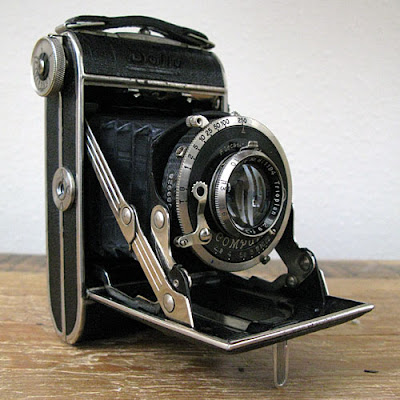The Certo Dolly Super Sport
is one of my favorite old folding cameras. I did not realize that until I had traded away my first one, and I ended up buying four more. Some of my other medium format cameras are more compact and have somewhat more sophisticated lenses and shutters. The Dolly, however, can do a variety of things the others can't.
For starters, the Dolly originally came equipped with two frame masks which allowed putting 12 6x6 frames on a roll of 120 film, or by clipping in the 6x4.5 mask, getting 16 shots on a roll. Certo also offered a amazing array of accessories for that time for the Dolly, including interchangeable lenses, and camera backs which allowed the use of sheet film and plates. As it turns out, it is also easily possible to use 35mm film in the Dolly.
The Dolly film compartment, unlike those in most medium format cameras, will actually allow dropping in a standard 35mm cartridge with no modifications needed. Then, you thread the film leader into the take-up spool, give it a few turns and close the back. Since there is no paper backing on the 35mm film, it is a good idea to tape over the three windows on the camera back to insure that no light leaks in to ruin your film. If you have the 6x6 cm mask in place, the exposures you make in the Dolly using 35mm film will give you panoramic frames nearly twice the width of a normal 35mm shot, as well as showing an interesting line of sprocket holes along the top and bottom borders.
The final thing to bear in mind about using 35mm film with no paper backing in the Dolly is that you must come up with some way to advance the film for each frame by turning the film advance knob just the right amount to ensure proper frame spacing. I've done this with a number of other medium format cameras by experimenting with a roll of film with the back open to determine the right amount to turn the advance knob as I work through the roll. The amount of turns does vary slightly due to the increase in diameter of the film roll as it goes onto the take-up reel.
The clever Dolly as it turns out has a built-in solution to the film advance problem. There is a circular index dial on the face of the take-up knob which allows advancing the film without reference to the numerals imprinted on the paper backing of the 120 film normally used in the camera.
After you load the 35mm cartridge into the Dolly, you will want to give the advance knob several full turns to bring an unexposed section of film into position. As you are coming to that point, just be sure that you end the last turn with the numeral "1" at the index mark on the post beside the knob. After making the first exposure, you will then turn the advance knob a full 360 degrees plus a little more to get to the numeral "2" on the dial. And so on up to the twelfth exposure. Examining the dial closely, you wil see that the amount indicated to turn decreases slightly on each exposure so that by frame 10 you will actually be turning the advance knob less than a full turn.
Well, so that has gotten you to the twelfth frame with very precise spacing. After that you're on your own, assuming you have loaded a 24 or 36-exposure roll of 35mm. If you still have some unexposed film left I guess you could engage in some higher mathematics to calculate the advance routine for any remaining length of the roll, but I think I'd just go with around three-quarters of a turn for any remaining frames and accept the fact that the spacing is going to get a bit wider as you go.
I only tried 35mm in my Dolly on one occasion a few years ago. I shot with the 6x4.5 mask, so I did not get the nice panoramic effect, but I thought having the image overlap the full width of the fillm and show the sprocket holes was pretty neat. I also just took a best guess on the film advance. It was a lot of fun and gave me a series of images I liked.














5 comments:
Well now isn't this timely! :-)
This will move my Super Sport Dolly way up in the to-shoot queue. Thanks!
The Dolly is exceptionally sturdy and using it with 120 film is generally uncomplicated. As with any of the old folders, it is important to check that the shutter is working, that the bellows are free of pinholes, and that the focus of the lens at infinity is correct.
If 35mm is shot in the camera and you don't process your own film, you would need to open the camera in the dark and re-roll the film back into the cartridge.
Wonderful photos...and I love vintage! Thanks so much for sharing.
Thanks, Linda.
I always enjoy the opportunity to make a connection with other photo enthusiasts around the world.
Brilliant idea... I'm definitely going to give this a try.
Thanks,
James
Post a Comment